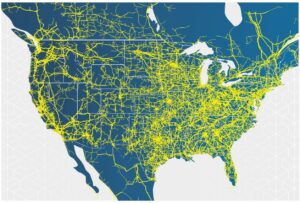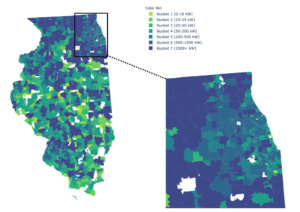June 23, 2022
Grid Planning: What’s At Stake for Communities
Equity and decarbonization are inseparable twin goals. Both require planning for a more decentralized and transparent power grid.
Climate change, increasing use of renewable and distributed energy, and recent legislation has put the electric grid on the front (hopefully induction) burner of environmental discussions. Our electricity comes from different places now, like rooftop solar panels and rural wind farms, as we shift away from big, centralized sources like coal plants. The grid is changing to match new needs and technology, and the stakes are high for consumers. Affordability, reliability, and the path of the clean energy transition are on the line.

Transmission Lines are part of the electricity grid
At the national level, the recently-passed Infrastructure Investment and Jobs Act includes $27.65 billion for improved grid resilience and reliability. In the Midwest, utilities are investing heavily in their electric distribution systems, with Xcel (MN), ComEd (IL), Ameren (IL), and DTE (MI) each proposing expenditures of hundreds of millions and sometimes more than a billion, annually.[1]
In addition to new funding, there are increasing opportunities for community participation. Illinois’ groundbreaking Climate and Equitable Jobs Act (SB2408) establishes the nation’s most comprehensive, detailed, and inclusive distribution grid planning requirements, which (among many other features) mandate that electric utilities disclose how their grid modernization plans will benefit low-income and environmental justice communities. Grid planning is changing across the Midwest and utilities’ Integrated Distribution Plans, which are presented to states’ Public Utilities Commissions, are a venue to push for both environmental protection and better grid outcomes for communities.

Solar energy development across Illinois, by zip code, with Chicagoland closeup map. Illinois Adjustable Block Program, 2019-2021
In 2021, ELPC and other environmental advocacy groups participated in a series of Grid Equity and Inclusion Planning Sessions with partners from Midwestern community-oriented, energy justice, and grassroots groups to discuss how equity and environmental priorities can be advanced, together, through grid planning work. These ongoing sessions are leading to new partnerships and strategies in Midwest grid-related cases, and we are grateful for the participation and leadership of Blacks in Green, Cooperative Energy Futures, Illinois People’s Action, Community Power, Little Village Environmental Justice Organization, Soulardarity, and others who are engaging in work with us throughout the Midwest.
What’s at stake
Reliability
We expect the lights to turn on when we flip the switch, the refrigerator to keep running, and our alarms to go off in the morning. In short, we expect reliability from the grid. Reliability is more than just a matter of comfort. Power outages have an enormous human and economic cost. In February 2021, a polar vortex caused massive blackouts in Texas leading to over 200 deaths and $130 billion in economic losses. A subsequent study found that low-income and minority communities were disproportionately affected by the storm and its fallout.
Through our work with frontline partners, ELPC is learning how community and environmental justice organizations have long pushed for using an economic and racial justice lens to understand the disparate impacts of our energy system. By applying this lens, advocates can, first, see how grid service works across racial and class lines and, second, push for modernization that alleviates rather than exacerbates inequality. This first step requires accessible, clear, and complete data from utilities—in other words, transparency. For example, in response to August 2021 storms, Michigan regulators will now require utilities to release data about system reliability, outages, and storm response. By collating this with demographic data we can see where and for whom the grid should be updated first.
Affordability

Rooftop solar installation in Illinois, Elevate Energy
Along with reliability, affordability is often a top concern for consumers and community advocates. Grid transformation is an expensive undertaking and it is imperative that disadvantaged communities do not foot the bill. Wealthy, commercial, and industrial customers should not be subsidized by the poor. The portion of income used to pay for energy bills, known as energy burden, varies widely. Black households spend 43% more of their income on energy bills than their white (non-Hispanic) counterparts while Hispanic households spend 20% more and Native American households 45% more.
Affordability is also a matter of safety. When COVID-19 hit, many of those already struggling with high energy burdens lost their jobs. Utilities began shutting off service to those unable to pay their bills. Without electricity there is no air conditioning, which can exacerbate respiratory issues, and without hot water it can be difficult to maintain sanitary conditions. Shutoffs also cause people to move in with friends and family. All of this was a perfect storm to make a crisis even worse, with catastrophic effects. A working paper by the National Bureau of Economic Research found that a nationwide moratorium on utility disconnections from March to November 2020 would have reduced COVID-19 infections by 8.7% and deaths by 14.7%. The human toll of unaffordability was over 40,000 lives.
The Path of the Clean Energy Transition
The clean energy transition requires the expansion of renewable energy, such as wind and solar, but these power sources, particularly solar, can take different forms. Solar production ranges from enormous “solar farms” with capacity in the hundreds of megawatts to relatively tiny rooftop solar on individual houses. A growing body of research shows that rapid expansion of local, distributed solar and storage is necessary to achieve carbon and equity goals at lowest cost. We need an electric grid that is ready for it.
An enormous challenge for homeowners and community groups engaged in rooftop and community solar is the need to interconnect to the grid. Interconnected solar can send excess power back to the grid. That electricity goes through “feeders” that have voltage and capacity limits. The question becomes, what happens when adding more solar runs up against these limits at particular parts of the grid? And how can we target our grid investment to make it easier, cheaper, and safer to add the solar we need to reach our clean energy goals?
Conclusion
Grid planning offers an opportunity for previously ignored voices to be heard and to actively shape and contribute to electric industry policy choices that will have far reaching effects. The challenge is that how, where, and when to shape these decisions is not always clear. Both utilities and state regulators are hearing input at an unprecedented level. Do they have the capacity to listen and implement? At ELPC we’re learning through our work with colleagues that equity and decarbonization are twin goals. One cannot be fully accomplished without the other, and each bolsters the other. Both require planning for a more decentralized power grid that offers robust opportunities for communities to own DERs and creates jobs that rebuild local wealth and economic resilience.
[1] Xcel Energy in Minnesota submitted an Integrated Distribution Plan that includes an average budget of $148.1 million per year from 2022-2026. Illinois’ Ameren plans to spend an average of $95.25 million per year from 2022-2025, while ComEd plans an average of $737.5 million per year on system performance. Due to regulatory differences between states and differences in how utilities classify investments, there is not a clear “grid modernization” category that can be easily compared across entities.

